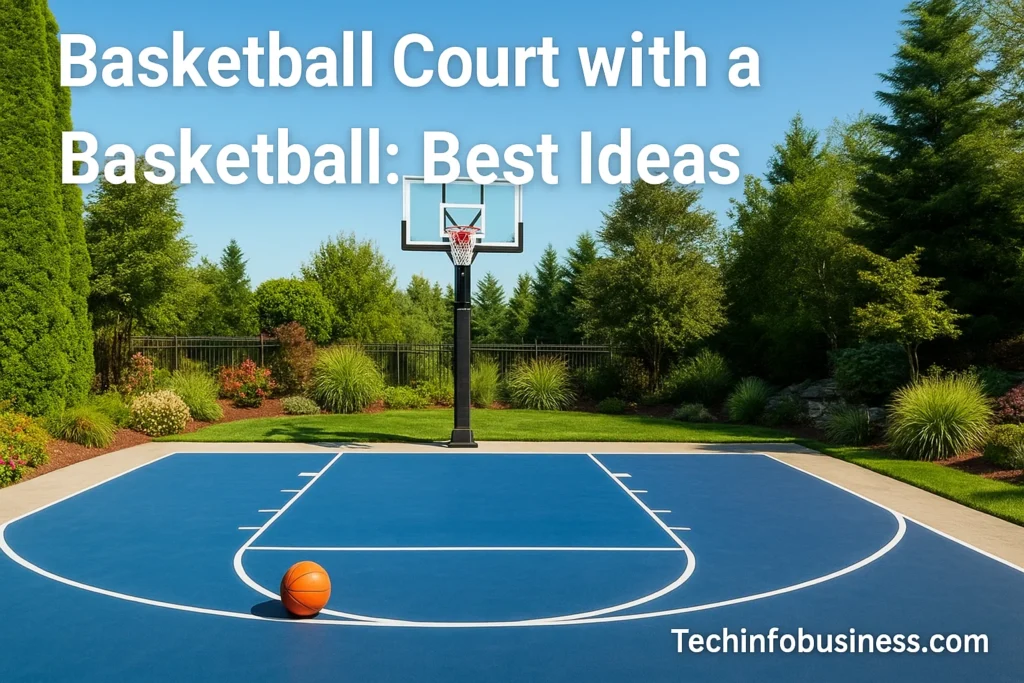Creating a basketball court with a basketball hoop in your own garden or outdoor space is a dream for many sports enthusiasts across the UK. Whether you’re an aspiring player, enjoy friendly matches, or simply want to practice your shots, having a dedicated basketball court at home can be incredibly rewarding. This guide will cover the essential features you need to consider when planning, building, and maintaining a basketball court in the UK, from the court size and surface material to the installation of the hoop and safety measures.
Understanding Basketball Court Dimensions
The first and most crucial aspect of building your own basketball court is deciding on the court’s size. Depending on your available space and how much of a full-court experience you want, there are various dimensions to consider.
Regulation Court Dimensions
A full-size professional basketball court, typically used in leagues like the NBA, measures 28.65 metres (94 feet) in length and 15.24 metres (50 feet) in width. However, such a large space is not always practical for a home court. If you’re building a court in your garden, you may need to adjust these dimensions based on the available space.
UK-Specific Court Sizes
In the UK, many basketball courts follow FIBA (International Basketball Federation) standards, which are slightly smaller than the NBA regulation size. A typical FIBA court measures 28 metres (92 feet) long and 15 metres (49 feet) wide. This makes it more suitable for home setups where space may be limited.
For a smaller area, such as a typical UK garden, you can create a half-court that measures around 14 metres by 15 metres. This is an ideal option for casual games or practising shooting skills.
Choosing the Right Surface Material
The material you choose for the surface of your court plays a huge role in both the playability and longevity of your court. Different materials cater to different needs, especially considering the UK’s varying climate.
Asphalt and Concrete
Asphalt and concrete are the most commonly used materials for outdoor courts due to their durability and relatively low cost. In the UK, where weather conditions can be quite unpredictable, it’s crucial to ensure the surface is sealed to prevent rainwater from causing cracks and deterioration. Asphalt offers a smoother finish, but concrete is slightly more durable and resistant to wear.
Outdoor Court Tiles
For a more cost-effective solution, modular outdoor court tiles offer an easy-to-install alternative that is weather-resistant and provides excellent traction. These tiles are a great choice for smaller spaces and can be laid over an existing surface.
Indoor Court Surfaces
If you’re considering an indoor setup, wooden floors, especially maple wood, are typically used for professional courts in the UK. Wood provides a consistent bounce and a smooth playing surface but can require more upkeep to prevent wear from foot traffic.
Installing the Basketball Hoop
The basketball hoop is at the heart of your court, and its installation should be done carefully to ensure safety and performance.
Hoop Height and Regulation Standards
The standard height for a basketball hoop, whether in the UK or internationally, is 3.05 metres (10 feet) from the surface of the court to the rim. This is the same across all professional courts and ensures consistency for players of all levels. Although this height can be adjusted for younger players or casual use, maintaining this standard height ensures the most authentic playing experience.
Backboard Material
For the backboard, tempered glass is the preferred material for its clear, smooth rebound, though it can be more expensive. Alternatively, acrylic backboards are more affordable and still offer decent rebound performance. Either material is suitable for a UK-based court, depending on your budget and preference for durability.
Mounting the Hoop
There are two main types of hoop mounting systems: in-ground and portable. In-ground poles, which are buried in concrete, offer a more stable and permanent option for a residential court. Portable hoops are ideal for a more flexible setup, though they may not be as stable during vigorous play.
Marking the Court Lines
Marking the court lines is essential for defining the play areas and making the game more structured and enjoyable.
Key Lines on the Court
Standard basketball courts in the UK feature several key markings:
- Baseline: This is the boundary line behind each basket.
- Sidelines: These mark the outer limits of the court’s length.
- Free-Throw Line: Set 4.57 metres (15 feet) from the backboard.
- Three-Point Line: In the UK, the three-point line is 6.75 metres (22 feet) from the basket, in accordance with FIBA rules.
- Half-Court Line: Divides the court into two halves.
Using high-quality, weather-resistant paint is crucial for ensuring the longevity of these markings, especially in the UK’s rainy climate.
Installing Proper Lighting for Night Play
If you intend to use your court during the evening, installing proper lighting is essential. The UK experiences long winter nights, so having adequate lighting will allow you to play at any time.
Types of Lighting
Floodlights are ideal for providing even lighting across the entire court. LED floodlights are a popular choice due to their energy efficiency and long lifespan. They emit a bright, clear light that can illuminate the court without the risk of creating harsh shadows.
Placement of Lights
Place the lights high up, ideally on poles around the perimeter of the court. This will help illuminate the playing area while reducing glare that could interfere with gameplay.
Safety Considerations for a Basketball Court
Safety is crucial, particularly if your court is being used by children or for competitive games. Several measures can be taken to ensure the court remains a safe space for play.
Surface Maintenance
Ensure the court surface remains free of debris such as leaves, twigs, or water puddles, which could cause players to slip or trip. Regularly inspect the surface for cracks or damage, especially after extreme weather conditions, which are common in the UK.
Padding and Protection
Install padding around the hoop, backboard, and pole to protect players from injury in case of collisions. Padding is especially important in a home setup, where there may not be a large buffer zone between the court and any surrounding structures.
Clearance Space
Ensure there is adequate space around the court. Having at least 1-2 metres of clearance along the sides and behind the basket will reduce the likelihood of accidents.
Maintaining Your Basketball Court
Maintaining your basketball court will ensure it remains in good condition for years to come.
Court Cleaning
Clean the court regularly by sweeping away debris like leaves or dirt. A leaf blower can help clear large areas quickly. In the UK, where rain can leave wet patches, it’s important to ensure the court remains dry and clean to avoid slippage.
Sealing the Surface
Seal the court surface every 1-2 years to protect it from the UK’s unpredictable weather, including rain and snow. This will extend the lifespan of your asphalt or concrete surface.
Inspecting the Hoop
Ensure the hoop is secure, and check for wear and tear. Tighten bolts and inspect the structure regularly, particularly if it’s an outdoor hoop exposed to the elements.
Read More: Unlocking the Zuyomernon System Basketball: A Game-Changing Coaching Blueprint
Conclusion
Building a basketball court with a basketball hoop at home is an exciting and rewarding project, but it requires careful planning and execution. By choosing the right dimensions, surface material, hoop installation, and safety features, you can create a space that provides hours of entertainment and improvement in your game. For UK homeowners, ensuring proper drainage, weatherproofing, and using durable materials is essential to combat the UK’s often wet and cold climate. With regular maintenance, your basketball court will offer years of enjoyment and become the go-to destination for fun, fitness, and competitive play.



